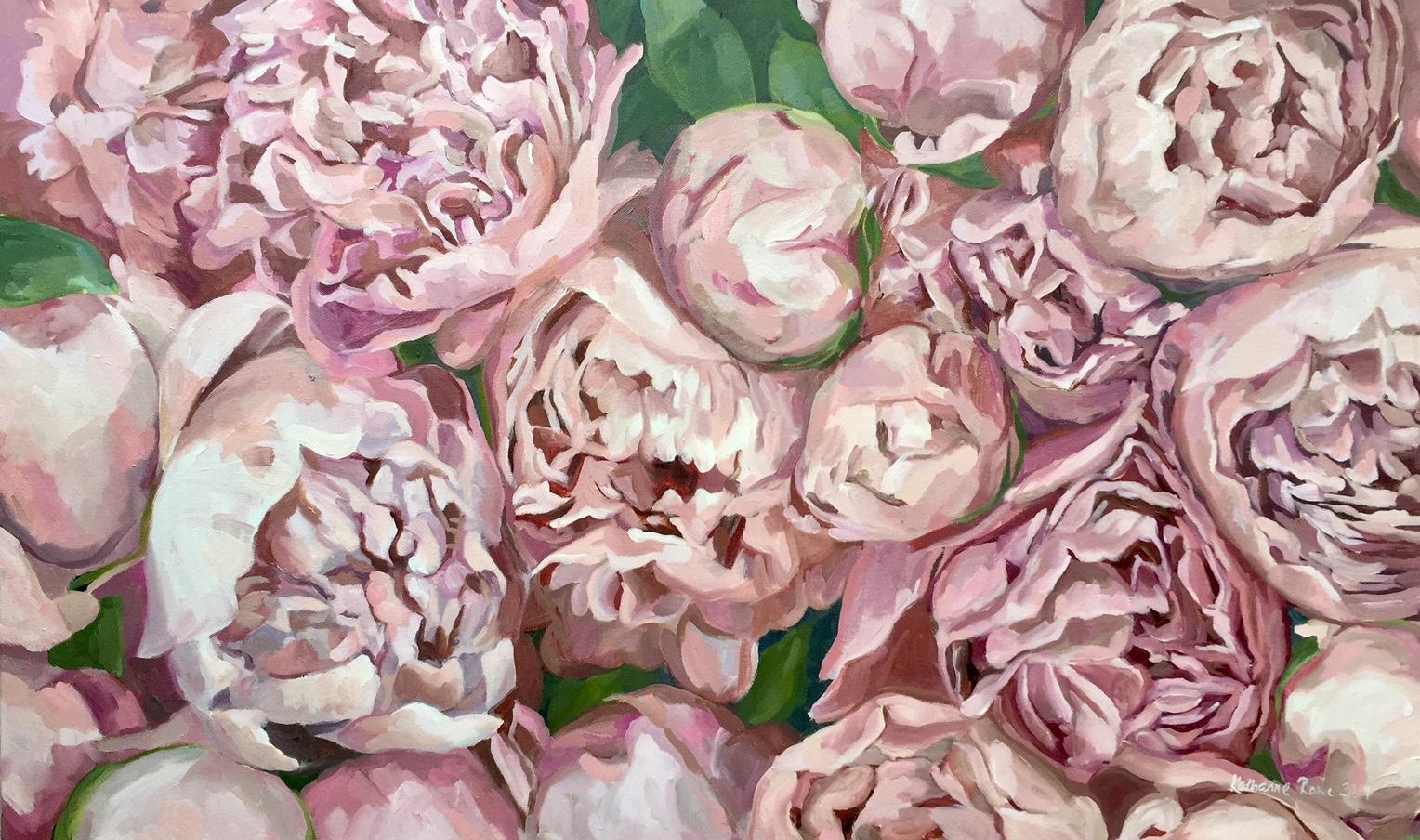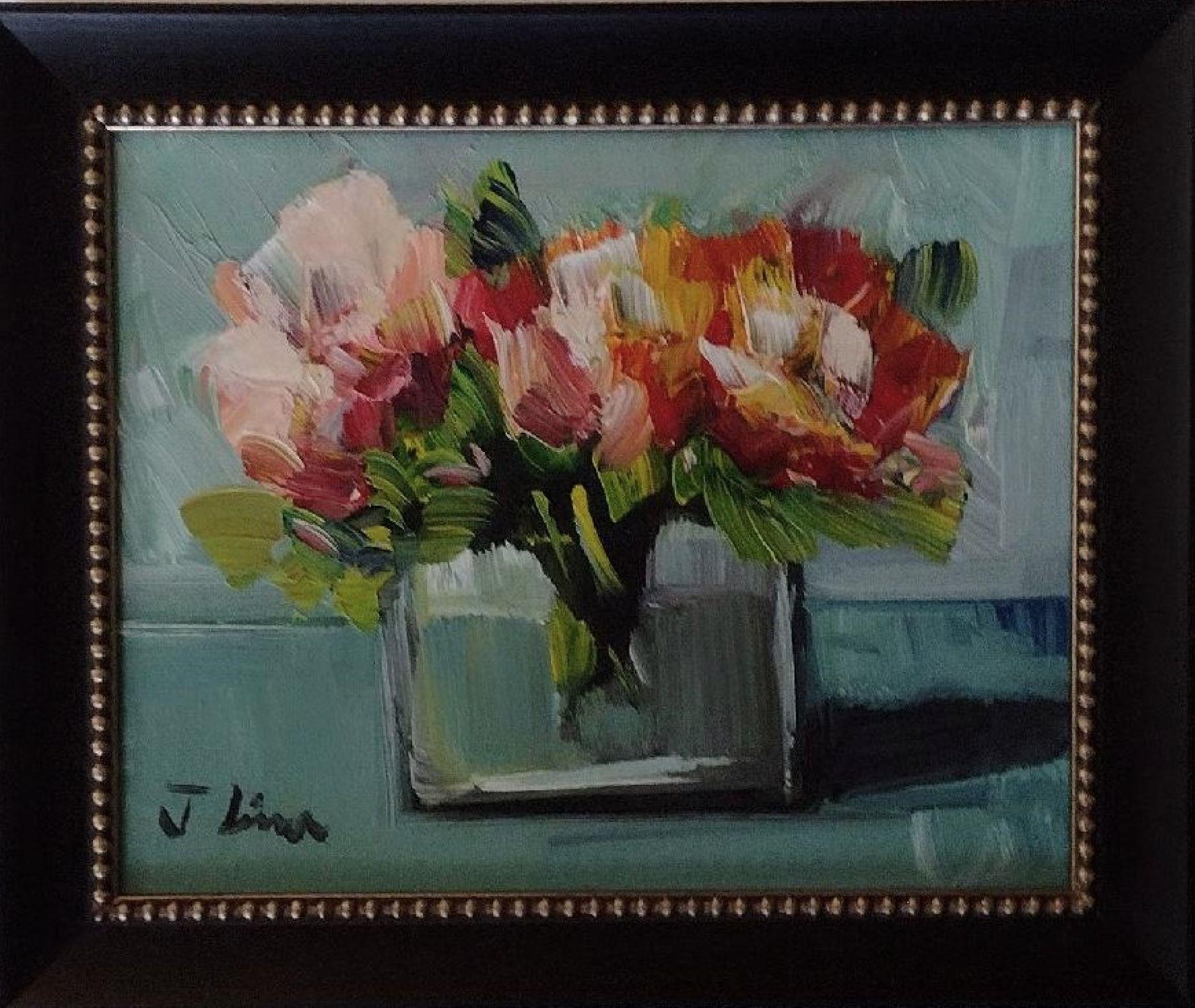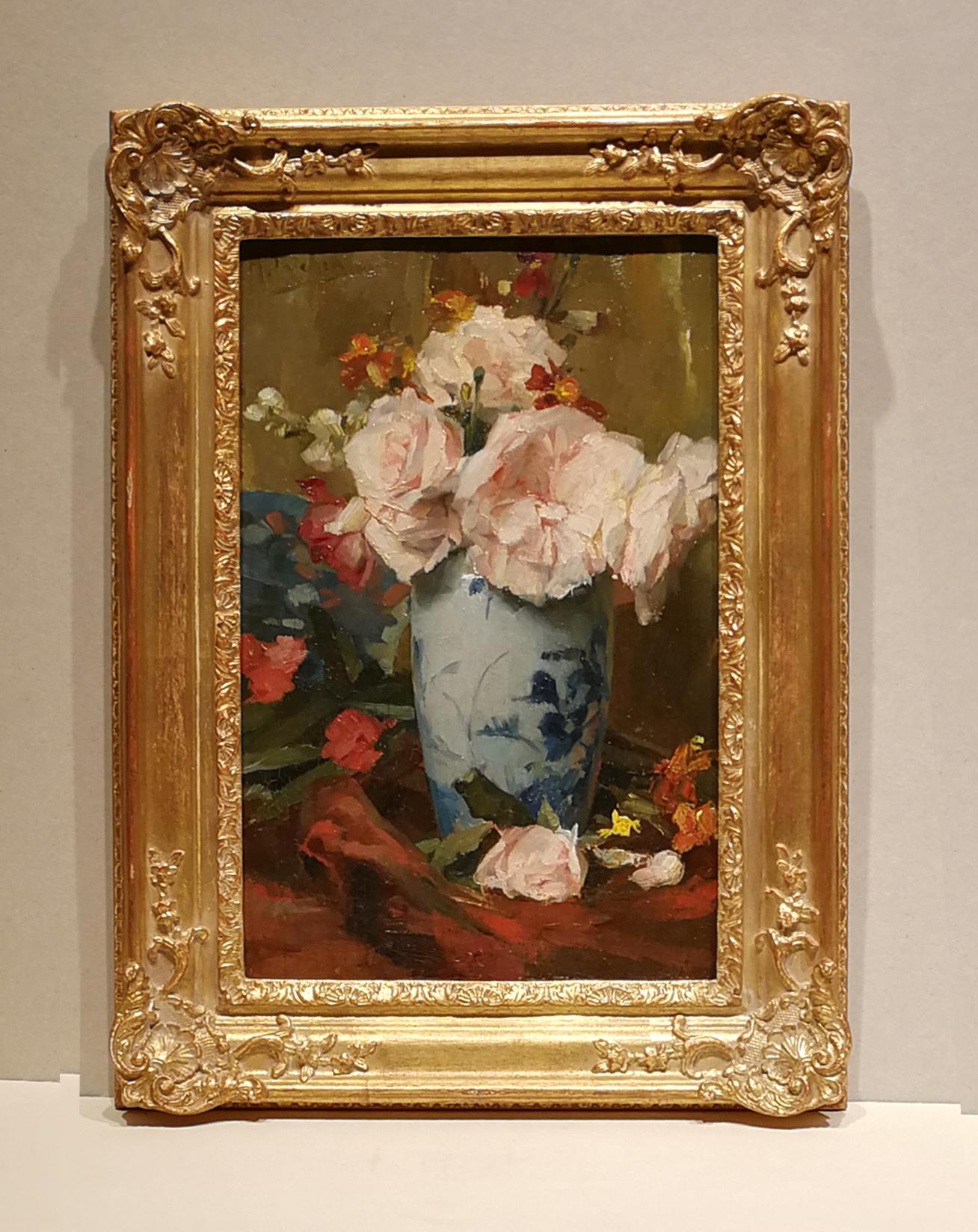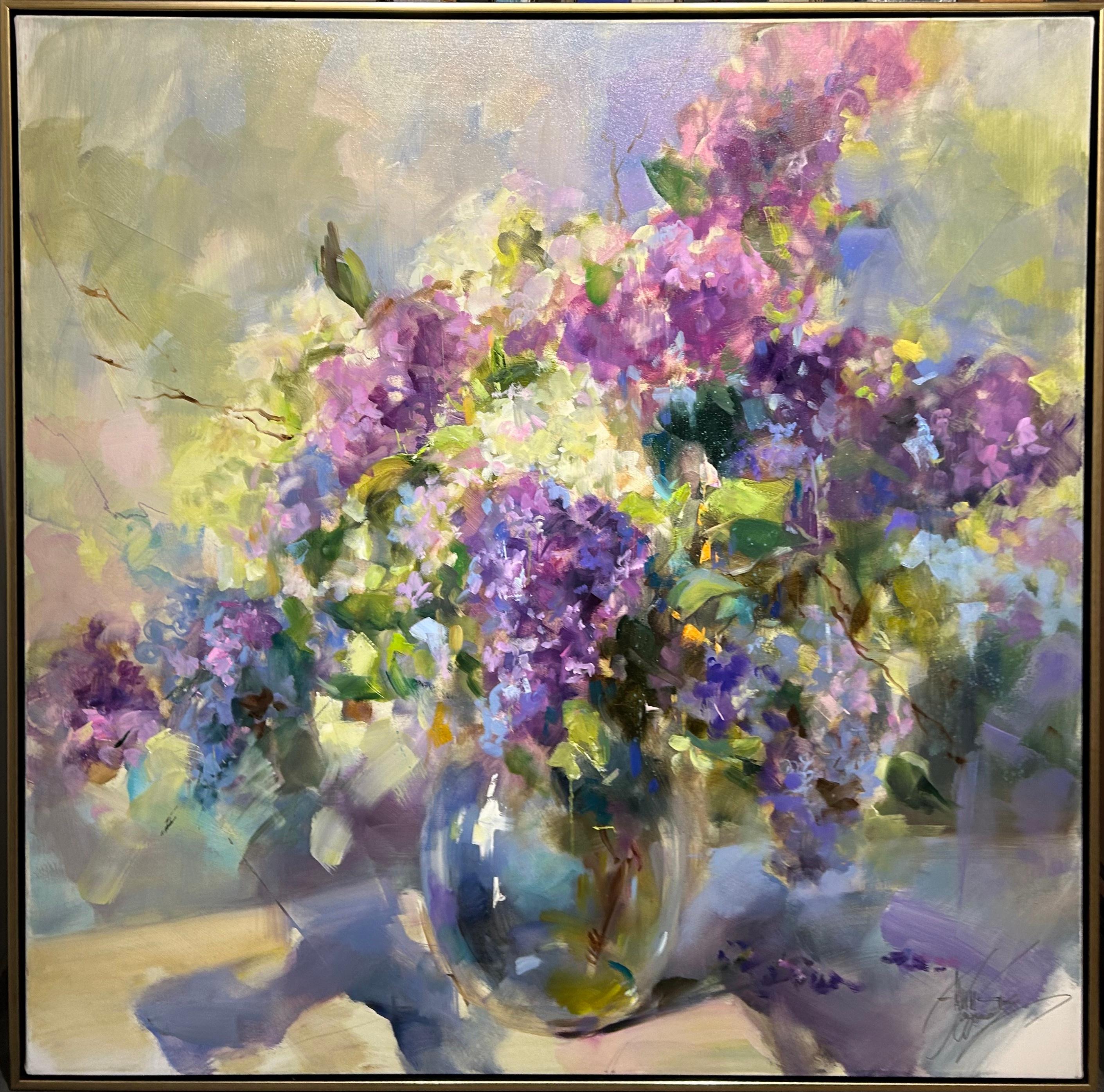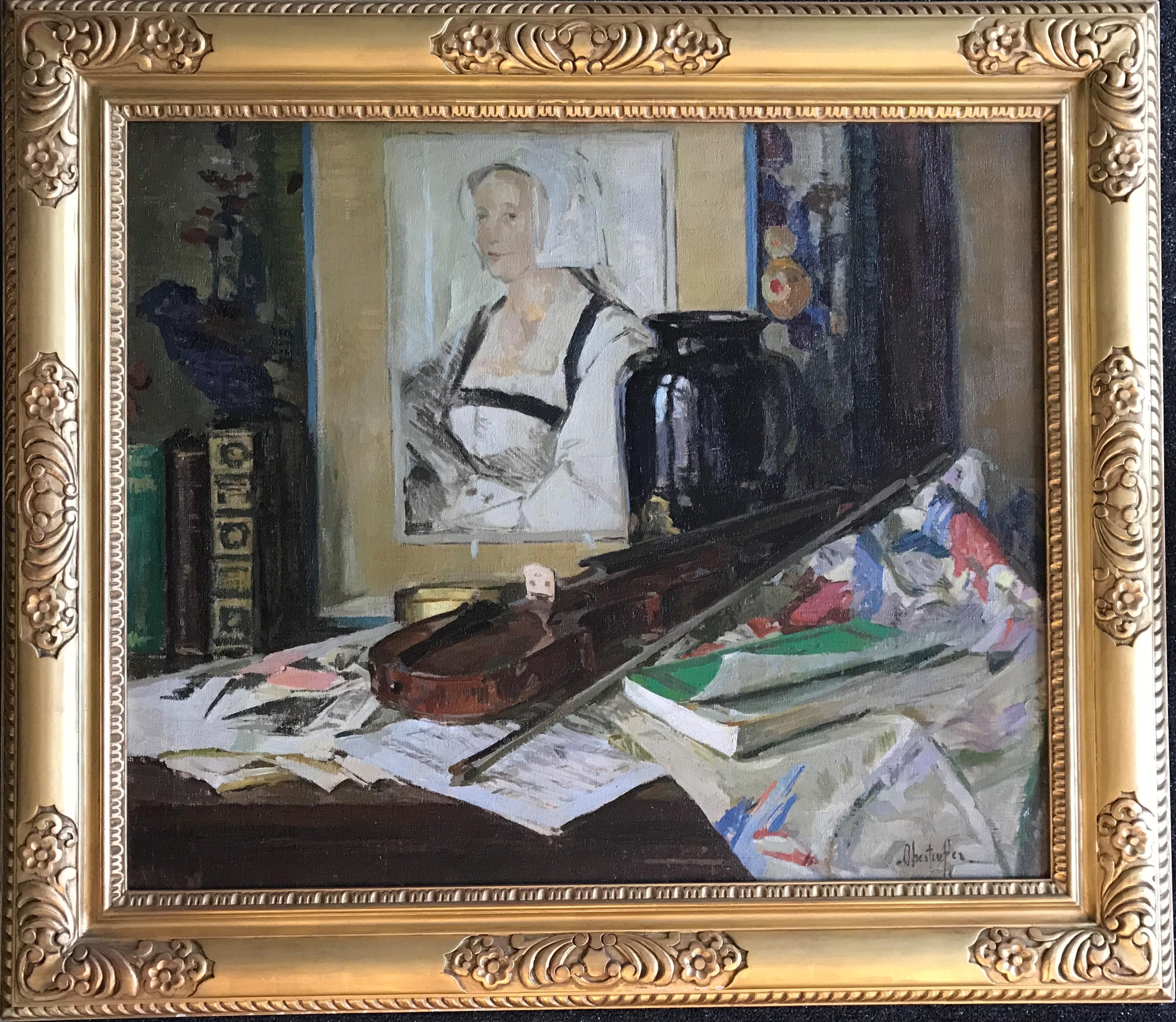Items Similar to A Still Life of Roses in a Ceramic Vase. An oil on canvas
Want more images or videos?
Request additional images or videos from the seller
1 of 11
Marcel DyfA Still Life of Roses in a Ceramic Vase. An oil on canvas
About the Item
Marcel DYF
1899 - 1985
This piece has been confirmed by Claudine Dyf
Picture Size: 18 x 22" (48 x 55cm)
Outside Frame Size: 25 x 29" (63 x 73cm)
A highly desirable still life with the roses placed in a wonderful ceramic jug.
Dyf’s family lived in Paris, but he spent his childhood holidays in Normandy at Ault, Deauville, and Trouville. The artistic climate to which he was exposed in Paris and in Normandy was crucial during his youth, as innovative ideas and new thinking, born of the Impressionist and Post-Impressionist movements, formed ever widening circles of influence in Europe. Swept up in the atmosphere, Dyf decided in his early twenties to give up his career in engineering and become an artist.
He moved to Arles in 1922 to pursue his calling and he kept a studio there until 1942. He had little formal artistic training but owed much of his inspiration to the great masters of the past such as Rembrandt, whom he particularly admired, Vermeer and Tiepolo. In Provence, challenged by a new range of colours and light, by new landscapes and images and under the same intense sky that lent its brilliance to Van Gogh’s art, Dyf graduated from painter to artist. Whilst living in Arles, Dyf was commissioned to paint a number of large historical and decorative works, mostly frescoes, in the town halls of Saint Martin-de-Crau and Les Saintes Maries-de-la-Mer, in Arles, in the Museon Arlaten and in the dining hall of the Collège Ampère. He also designed windows for the church of Saint Louis in Marseille.
In 1935 Dyf took on Maximilien Luce’s old studio in the Avenue du Maine on the left bank. His partial return to Paris meant that he could work with many whose names became renowned for their highly original contributions to art, music, and literature. Paris hummed with creative vitality in the 1930s and Dyf was both participant and recipient in the atmosphere.
Paris was shattered by the invasion of 1940. Like many others, Dyf left the city and returned to Arles, but he quickly had to abandon his home in the south and he took to the Maquis, entering the Résistance in Corrèze and the Dordogne. After the Liberation he returned to Arles to find the studio reduced to rubble in the fighting. He retreated, heavy-hearted, to Paris but the pull of the Midi was deep-rooted, so in time he returned and made a new base in Saint Paul-de-Vence. Thereafter he divided his time between Paris and the south.
His pictures began to sell through galleries in Cannes, Nice, Marseille and Strasbourg. In Paris he exhibited and sold his paintings through the Salon d’Automne, the Salon des Tuileries and the Salon des Artistes Français.
In the first half of the 50s Dyf worked in Paris throughout the winter and spent the summer in Cannes, where he set up a studio-gallery and established a regular following among American visitors to the Riviera. In 1955 the first paintings were bought from Dyf by Frost & Reed to be sold in London, thus heralding the formation of a remarkable and enduring relationship between artist and gallery.
In the summer of 1954, Dyf met Claudine Godat. Aged 19, she was thirty-six years younger than Dyf and with her long fair hair, clear skin, vivacity and patience, she was what the artist felt to be his perfect model. It was simply love at first sight. There was an instant rapport between them and her arrival in his life acted as a catalyst, bringing Dyf’s art forward to the threshold of its most mature phase. In 1956, they married and bought a 16th century hunting lodge at Bois d’Arcy, near Versailles. This became their main home, but each winter they returned to Provence on painting trips, staying in Saint-Rémy or in the small village of Eygalières. The olive trees, the cane windbreaks and the grey-white crags of the Alpilles provided countless motifs for Dyf’s paintings of Provence, and his artistic and emotional attachment to the area endured to the end of his life.
In 1960, at Claudine’s insistence, they first visited Brittany. They explored widely and finally came upon the Golfe du Morbihan. Dyf was enchanted with this remote, beautiful region. He immediately saw the potential for new subjects, in the still waters of the huge lagoon surrounded by rolling fields of wheat and tiny clusters of slate-roofed cottages, and he knew he must return to paint there. From that time on the seasons of the year followed the same pattern: autumn was spent at home near Versailles and in the late autumn or early spring Dyf and Claudine drove south and spent six or eight weeks in Provence. In May they left for Brittany, where they spent the summer in a house they had bought opposite the church in the village of Arzon.
Two or three times a year Frost & Reed would visit Dyf and buy all the best of his works for their stock. Dyf could never work in an empty studio, he said that it deadens an artist’s inspiration, so immediately the paintings had left for London, he and Claudine would set off to the west or to the south in search of new inspiration. This annual round having been established, there followed many years of great fulfilment. The artist, free from the burden of running the more mundane side of his life, was now able to devote all his time to painting and through Frost & Reed, his sole world agent, he was guaranteed an outlet for his work.
To watch Dyf paint was entrancing. Even as an old man, he would stand rather than sit before the easel, working with extraordinary vigour and intense concentration. His palette was a rainbow of fresh colours and his hand continually darted back and forth from the canvas. At intervals he would step back or consider briefly another picture before returning to the easel, his eye refreshed. Usually he sketched straight onto the canvas, which he set up on his travelling easel. He would work on a subject for two or three hours and return the next day, in search of the same light on the landscape.
If he sketched, it would be in charcoal and he generally made a number of drawings to record the broad proportions and the minutiae of his subject. As soon as he reached home with a group of sketches he would begin work instantly, drawing on his new ideas while the images were still fresh in his mind, so that soon he had pictures in all stages of completion in the studio. He worked on each canvas in the open air whenever possible. If he found himself doing so in a place where his presence drew onlookers, he tolerated their silence but would politely dismiss anybody who disturbed him with as much as one word. However, he truly detested being watched whilst he was drawing. He likened it to a person looking over his shoulder while he was writing a letter and regarded it as too personal and secret an act to share comfortably with others.
Throughout these years Dyf principally painted in three areas: Brittany, Provence, and the Ile de France, although he also travelled in Morocco, Venice, the United States, Holland and England. His artistic legacy will be a lasting one; he painted the landscape of France with an intensity of feeling that entirely matched his personality and with a vigour that never tired. His life yielded a rich harvest of work whose quality, once established, did not dwindle in his later years. His art is youthful, yet traditional, with a sensational use of colour. His paintings give an outward appearance of being simple, undemanding compositions, but the process of creating them was exactly the opposite - it was complex, rigorous, disciplined, considered, measured. The final effect, though, is to produce an art form that is so disarmingly uncomplicated that it remains, as the artist wished, accessible to all.
In the thirty years that have passed since Dyf’s death in 1985, Frost & Reed have continued to deal in the very best examples of his work - and who better to know which they are and where they are to be found! In the same way, the gallery’s association with Claudine Dyf has continued in a spirit of mutual affection; she it is who so generously and willingly does our research and confirms the location of the many fine landscapes that pass through our hands. We shall always be grateful to her, our living link with Dyf.
This piece has been confirmed by Claudine Dyf 2023.
- Creator:Marcel Dyf (1899-1985, French)
- Dimensions:Height: 29 in (73.66 cm)Width: 25 in (63.5 cm)Depth: 3 in (7.62 cm)
- Medium:
- Movement & Style:
- Period:
- Condition:
- Gallery Location:St. Albans, GB
- Reference Number:1stDibs: LU2469214347022
About the Seller
5.0
Gold Seller
These expertly vetted sellers are highly rated and consistently exceed customer expectations.
Established in 1965
1stDibs seller since 2023
19 sales on 1stDibs
Typical response time: 2 hours
- ShippingRetrieving quote...Ships From: St. Albans, United Kingdom
- Return PolicyA return for this item may be initiated within 7 days of delivery.
More From This SellerView All
- A Still Life of Figs and MelonLocated in St. Albans, GBJean Baptiste Olive This premiere piece shows his work and influence which he had with Antoine Vollon. It is in its museum quality gold leaf frame. The piece has been exhibited in many shows with the exhibition labels on the reverse testimony. Artwork Size: 22 x 18" (56 x 46cm) Artwork Size with Frame: 31 x 27" (79 x 69cm) Free Shipping French, 1848-1936 Jean-Baptiste Olive was undoubtedly one of the greatest masters of the Marseille school at the end of the 19th century, along with Paul Guigou...Category
Late 19th Century Impressionist Still-life Paintings
MaterialsOil
- A Still Life of BegoniasBy James Stuart ParkLocated in St. Albans, GBJames Stuart Park Scottish School Oil Canvas Picture Size: 30 x 24" (76 x 60cm) Outside Frame Size: 40 x 34" (102 x 86cm) Park lived from 1862 – 1933 and was born in Kidderminst...Category
Early 20th Century Impressionist Paintings
MaterialsOil
- Un Bouquet de Fleurs SpectaculaireBy Marcel DyfLocated in St. Albans, GBMarcel DYF 1899 - 1985 Oil on canvas Canvas Size 28 x 23" (72 x 60cm) Outside Frame Size: 36 x 31" (92 x 80cm) Free Shipping Dyf’s family lived in Paris, but he spent his childhood holidays in Normandy at Ault, Deauville, and Trouville. The artistic climate to which he was exposed in Paris and in Normandy was crucial during his youth, as innovative ideas and new thinking, born of the Impressionist and Post-Impressionist movements, formed ever widening circles of influence in Europe. Swept up in the atmosphere, Dyf decided in his early twenties to give up his career in engineering and become an artist. He moved to Arles in 1922 to pursue his calling and he kept a studio there until 1942. He had little formal artistic training but owed much of his inspiration to the great masters of the past such as Rembrandt, whom he particularly admired, Vermeer and Tiepolo. In Provence, challenged by a new range of colours and light, by new landscapes and images and under the same intense sky that lent its brilliance to Van Gogh’s art, Dyf graduated from painter to artist. Whilst living in Arles, Dyf was commissioned to paint a number of large historical and decorative works, mostly frescoes, in the town halls of Saint Martin-de-Crau and Les Saintes Maries-de-la-Mer, in Arles, in the Museon Arlaten and in the dining hall of the Collège Ampère. He also designed windows for the church of Saint Louis in Marseille. In 1935 Dyf took on Maximilien Luce’s old studio in the Avenue du Maine on the left bank. His partial return to Paris meant that he could work with many whose names became renowned for their highly original contributions to art, music, and literature. Paris hummed with creative vitality in the 1930s and Dyf was both participant and recipient in the atmosphere. Paris was shattered by the invasion of 1940. Like many others, Dyf left the city and returned to Arles, but he quickly had to abandon his home in the south and he took to the Maquis, entering the Résistance in Corrèze and the Dordogne. After the Liberation he returned to Arles to find the studio reduced to rubble in the fighting. He retreated, heavy-hearted, to Paris but the pull of the Midi was deep-rooted, so in time he returned and made a new base in Saint Paul-de-Vence. Thereafter he divided his time between Paris and the south. His pictures began to sell through galleries in Cannes, Nice, Marseille and Strasbourg. In Paris he exhibited and sold his paintings through the Salon d’Automne, the Salon des Tuileries and the Salon des Artistes Français. In the first half of the 50s Dyf worked in Paris throughout the winter and spent the summer in Cannes, where he set up a studio-gallery and established a regular following among American visitors to the Riviera. In 1955 the first paintings were bought from Dyf by Frost & Reed to be sold in London, thus heralding the formation of a remarkable and enduring relationship between artist and gallery. In the summer of 1954, Dyf met Claudine Godat. Aged 19, she was thirty-six years younger than Dyf and with her long fair hair, clear skin, vivacity and patience, she was what the artist felt to be his perfect model. It was simply love at first sight. There was an instant rapport between them and her arrival in his life acted as a catalyst, bringing Dyf’s art forward to the threshold of its most mature phase. In 1956, they married and bought a 16th century hunting lodge at Bois d’Arcy, near Versailles. This became their main home, but each winter they returned to Provence on painting trips, staying in Saint-Rémy or in the small village of Eygalières. The olive trees, the cane windbreaks and the grey-white crags of the Alpilles provided countless motifs for Dyf’s paintings of Provence, and his artistic and emotional attachment to the area endured to the end of his life. In 1960, at Claudine’s insistence, they first visited Brittany. They explored widely and finally came upon the Golfe du Morbihan. Dyf was enchanted with this remote, beautiful region. He immediately saw the potential for new subjects, in the still waters of the huge lagoon surrounded by rolling fields of wheat and tiny clusters of slate-roofed cottages, and he knew he must return to paint there. From that time on the seasons of the year followed the same pattern: autumn was spent at home near Versailles and in the late autumn or early spring Dyf and Claudine drove south and spent six or eight weeks in Provence. In May they left for Brittany, where they spent the summer in a house they had bought opposite the church in the village of Arzon. Two or three times a year Frost & Reed would visit Dyf and buy all the best of his works for their stock. Dyf could never work in an empty studio, he said that it deadens an artist’s inspiration, so immediately the paintings had left for London, he and Claudine would set off to the west or to the south in search of new inspiration. This annual round having been established, there followed many years of great fulfilment. The artist, free from the burden of running the more mundane side of his life, was now able to devote all his time to painting and through Frost & Reed, his sole world agent, he was guaranteed an outlet for his work. To watch Dyf paint was entrancing. Even as an old man, he would stand rather than sit before the easel, working with extraordinary vigour and intense concentration. His palette was a rainbow of fresh colours and his hand continually darted back and forth from the canvas. At intervals he would step back or consider briefly another picture before returning to the easel, his eye refreshed. Usually he sketched straight onto the canvas, which he set up on his travelling easel...Category
1960s Impressionist Still-life Paintings
MaterialsOil
- A Still Life of RosesLocated in St. Albans, GBKees TERLOW/ TERLOUW Panel Size: 24 x 48" (61 x 122cm) Outside Frame Size: 30 x 54" (76 x 137cm) Oil on panel A signature style piece with bold, beautifully painted roses and his ...Category
Early 20th Century Impressionist Still-life Paintings
MaterialsOil
- A Still Life of FlowersBy Dorothea SharpLocated in St. Albans, GBA wonderful example of Dorothea Sharp's still lifes. Full of vibrancy and effervescence this painting ,with her classic broad brush strokes, show her talent at its best. It is in a w...Category
Early 20th Century Impressionist Still-life Paintings
MaterialsOil
- A Still Life of the Madonna, Flowers and a China PotLocated in St. Albans, GBHenri Lucien Joseph BURON This is potentially Henri Buron's premier work of art. It was exhibited in the Salon des Artistes Française in 1934 having been painted in 1933. The revers...Category
1930s Impressionist Still-life Paintings
MaterialsOil
You May Also Like
- Jules Elie Peonies by Katharine Rowe floral painting of peoniesBy Katharine RoweLocated in London, GBKatharine spent a long time mixing paint to reach the right level of smokiness and avoid any saccharine pink in these peonies. They seem to be quite solid but at the same time quite delicate, they are a joy to paint. Katharine Rowe is an English painter she graduated in Fine Art and History of Art at the University of Edinburgh in 1999 and spent a year studying at Université de la Sorbonne, Paris. Having spent a decade working in advertising Katharine felt the increasing need to be out of the office and with her paintbrush. The past 9 years have been dedicated to just that. Katharine is strongly motivated by colour and she often spends up to an hour mixing and preparing paints before turning to the canvas. Katharine is always inspired by her surroundings from the varied landscapes of London...Category
2010s Impressionist Still-life Paintings
MaterialsOil
- Autumnal Hydrangea Paniculata in a Celadon Jug painting by Jonquil WilliamsonBy Jonquil WilliamsonLocated in London, GBJonquil Williamson is known for her vibrant still lifes and rich tonal landscapes. Although her work is mostly representational, she allows the mark-making and textures created as she layers the paint, to inform the image. Of her work she shares, “like many still life painters, I find inspiration from taking everyday things and elevating to something beautiful and positive. I strive to create an atmosphere with my works; from the calmness and serenity of Morandi-inspired clusters of pots and vessels...Category
2010s Impressionist Still-life Paintings
MaterialsOil
- Vase of Flowers III - Original Impressionist Oil Painting on Canvas 2022By Jose LimaLocated in Columbus, OHThis is an original Impressionist oil painting by American-Cuban Artist Jose Lima . He uses a wide spectrum of oil paint which captures the scene or object in a spontaneous vibrant I...Category
2010s American Impressionist Still-life Paintings
MaterialsOil
- Blue vase, Herman Richer, Oil Paint/panel, impressionstLocated in OOSTERBEEK, NLBelgium, 1866-1942 Herman Richir initially studied at the Art Academy of Sint-Joost-ten-Noode in Brussels, where he studied with Gustave Biot and Charles Hermans. He then went on to...Category
19th Century Impressionist Still-life Paintings
MaterialsOil, Panel
- Floral 'Never Enough II' Original Oil on Canvas PaintingLocated in Toronto, CAOriginal Oil on Canvas work by Russian-Canadian artist Anna Razumovskaya featuring impressionist style purple flowers and a vase. Razumovskaya's signature soft brushwork is on displa...Category
2010s American Impressionist Still-life Paintings
MaterialsCanvas, Oil
- Tabletop Arrangement, a still life oil painting by George OberteufferLocated in Hudson, NYClassic Impressionist still-life oil painting by American artist George Oberteuffer. Tabletop Arrangement (c.1925) Oil on canvas 30" x 36" 39 ½" x 45 ¼" x 2 ½" framed Signed "Ober...Category
Early 20th Century American Impressionist Still-life Paintings
MaterialsCanvas, Oil
